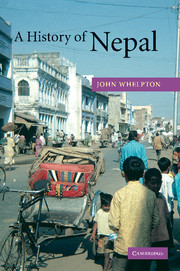Book contents
- Frontmatter
- Contents
- List of illustrations
- List of maps
- List of tables
- Key events
- Acknowledgements
- Notes on romanisation and terminology
- List of abbreviations
- Introduction
- 1 Environment, state and society in the central Himalayas to 1743
- 2 Unification and sanskritisation, 1743 – 1885
- 3 Nepal under the Shamsher Ranas, 1885 – 1951
- 4 The monarchy in ascendance: domestic politics and foreign relations, 1951 – 1991
- 5 The quest for ‘development’: economy and environment, 1951 – 1991
- 6 Lifestyles, values, identities: changes in Nepalese society, 1951 – 1991
- 7 Democracy and disillusionment: Nepal since 1991
- Genealogical tables
- Biographical notes
- Notes
- Glossary
- Bibliography
- Index
1 - Environment, state and society in the central Himalayas to 1743
Published online by Cambridge University Press: 05 June 2016
- Frontmatter
- Contents
- List of illustrations
- List of maps
- List of tables
- Key events
- Acknowledgements
- Notes on romanisation and terminology
- List of abbreviations
- Introduction
- 1 Environment, state and society in the central Himalayas to 1743
- 2 Unification and sanskritisation, 1743 – 1885
- 3 Nepal under the Shamsher Ranas, 1885 – 1951
- 4 The monarchy in ascendance: domestic politics and foreign relations, 1951 – 1991
- 5 The quest for ‘development’: economy and environment, 1951 – 1991
- 6 Lifestyles, values, identities: changes in Nepalese society, 1951 – 1991
- 7 Democracy and disillusionment: Nepal since 1991
- Genealogical tables
- Biographical notes
- Notes
- Glossary
- Bibliography
- Index
Summary
THE PHYSICAL ARENA
The history of the Himalayas began with the slow collision of what is now the Indian subcontinent with Central Asia. About 70 million years ago, this forced rock strata upwards to form the mountains along Tibet's southern rim, which are still today the watershed between the Ganges and Tsangpo/Brahmaputra river systems. Between 16 and 10 million years ago, further movements produced to the south the main Himalayan range and, to their south, the middle hills – a confusion of interrupted ridges and spurs, which in Nepal still form the cultural and political heart of the country. At around the same time the Tibetan mountains rose further and then, between 800,000 and 500,000 years ago, the main Himalayan peaks were again uplifted to tower far above them. Subsequent movements produced the Mahabharat hills along the southern edge of the middle hills and the Siwalik (or Chure) range slightly further south along the edge of the Gangetic plain. This shifting of the earth's crust continues today and different sections of the Himalayas are still rising at rates of between 5 millimetres and 1 centimetre per year.
The rise of the Mahabharats and the Siwaliks temporarily dammed some of the rivers flowing south towards the Ganges, forming lakes in the valleys between the two ranges and also in the Kathmandu Valley. The Kathmandu lake may have dried up only 100,000 years ago, by which time its shores were almost certainly inhabited. The mythical account of the draining of the Valley by Manjushri (Buddhist version) or Pradyumna (Hindu version), like the similar myths encountered all along the Himalayas, could just conceivably represent an oral tradition dating back more than 3000 generations. It is, though, more likely that the myth-makers simply drew their conclusion from the lie of the land. By way of comparison, there is a Chinese folk story about a land link between Taiwan and the mainland, which were in fact joined until around 8000 bc, but no folk memory of the land bridge between Britain and mainland Europe, which existed until about 7000 bc.
- Type
- Chapter
- Information
- A History of Nepal , pp. 6 - 34Publisher: Cambridge University PressPrint publication year: 2005
- 1
- Cited by



